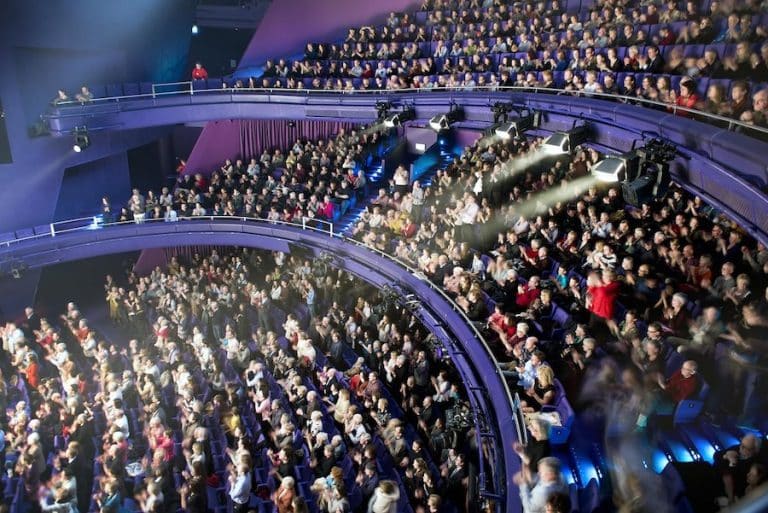Who were the real Peaky Blinders? Uncover the truth behind the legend at this Manchester Funzing talk
- Written by Louise Rhind-Tutt
- Last updated 5 years ago
- City of Manchester, Events, People, Sponsored, TV & Radio

The fictional Peaky Blinders on our TV screens are infused with drama and dread. Fashionably dressed, the charismatic but deeply flawed Shelby family would blind enemies by slashing them with the razor blades stitched into the peaks of their flat caps. It’s gruesome stuff from Birmingham’s answer to the Sopranos.
But who were the real Peaky Blinders? Were they anything like we see on the award-winning BBC show, now in its fifth series? Did they even have blades in their caps at all?
Well-known social historian professor Carl Chinn (MBE) has spent decades researching the real Peaky Blinders, one of whom was his own great grandfather. And next month he’s coming to Whitworth Locke to tell Manchester audiences more about the real-life gangs.
We caught up with him ahead of his Manchester talk and the forthcoming publication of his new book Peaky Blinders: The Real Story to find out more.

“The Peaky Blinders of Birmingham legend have become a worldwide sensation, but it is vital to understand the realities behind the dramatized gangsters,” says Carl.
Let’s start with the name, then, which is infused with fear. Did the gang really blind their enemies?
“There is no evidence at all to suggest they had blades in their hats,” reveals Carl, who started researching the Victorian and Edwardian street gangs in the 1980s and has collected over 40,000 letters from people telling him their personal stories.
“I’ve gone through hundreds of court cases and newspaper articles and there is absolutely no evidence. That’s a myth that emerged in the late 1920s in the papers, and it took off in the ‘50s.”
So, where did the name come from? They did wear caps, didn’t they?
As well as distinctive bell-bottomed trousers and buckled belts, the gangs wore the peaks of their hats “pulled down over one eye which revealed their quiffs,” explains Carl. And they did not belong to a single gang, but rather opposing gangs who sought each other out on the streets of Birmingham.

And while the TV series is set in the 1920s, the term Peaky Blinder was actually adopted in the 1890s, although clashes between rival youth gangs were first reported in the city during the early 1870s.
The name itself was exclusive to Birmingham. In Manchester and Salford, gang members were known as ‘scuttlers’. In London, they became known as ‘hooligans’, a name with a more lasting impact.
Aside from the fact that disposable razor blades were not readily available at the time, the violent Peaky Blinders didn’t need blades in their hats to cause damage, says Carl.
“They used their boots. And their main weapon, just like the Scuttlers in Manchester and Salford, was their belts. They wrapped them round their wrists, and the buckles caused terrible injuries.
“They wanted to maim. They were vicious men, but they were not big gangsters like we see in films. A few, like Billy Kimber, went on to become major gangsters, but that was a minority.”

While the Shelbys themselves are a fictional family, Billy Kimber, who appears in the first series, was a real person. But he wasn’t from London, as you might have believed from watching the TV show.
“Billy was a real character, and he was a Brummie,” says Carl. “He led a collection of racecourse ruffians and pickpockets that dominated the racecourse scene. And he had been a Peaky Blinder.”
And like the Shelbys, Carl’s own grandfather was also an illegal bookmaker in the back streets of Birmingham in the 1920s.
“My dad was president of The Birmingham Bookmakers Protection Association, and he put me in touch with a load of old bookies. Through them I was put in touch with the younger brother of the real Alfie Solomons [played by Tom Hardy in the series], who I interviewed in 1986.
“And they also put me in touch with Dave Langham, whose father was George Langham, real name Angelo Gianicoli – one of the men in Sabini’s gang. So, in the 1980s I was already writing about the racecourse war that erupted in 1921 between Sabini and Solomons on one side and the Birmingham Gang, led by the real Billy Kimber.”

The men are recognisable, but women also play an important role in the TV series, which is dominated by matriarch Aunt Polly. Did women have any part in the real gangs?
“In my new book I say that the real heroes of the backstreets were not the men, it was the women, who didn’t turn to criminality but who strove every day against an enemy called poverty. And for the most part they did so with dignity,” says Carl.
“There is very slight evidence that some women may have joined in with some of the gangs, and there is some evidence of women in Birmingham adopting the Peaky Blinders fashion with a very long fringe at the front, and they would wear ostentatious hats.

“But there is very little evidence I’ve come across that there were women in the Peaky Blinders. And with those gangs of the 1920s, there is no evidence that wives or girlfriends played any part.”
However, like in the TV drama, confrontation between the real-life gangs and the police were rife, and the police were physically trained to deal with the new threat.
“They hated the police,” says Carl.
“In Birmingham it was known as ‘constable baiting’. Three police officers were killed between 1875 and the early 20th century, and others suffered serious injuries.
“Many had to leave the police force because of the beatings they received.”

But like the gangs in Manchester and Salford, the Sluggers and Peaky Blinders began to fade away in the early 20th century.
“That’s because of forceful policing and much stronger sentencing for assaults on the police,” says Carl.
“But also, similar to Manchester and Salford, there were social changes which happened organically. Football became a participatory sport as well as a spectator sport. Lots of 13, 14 and 15-year-old lads started to play in their dinner hour. And another new sport that was really important was boxing, and the emergence of clubs.
“And there was another new phenomenon then, too: the pictures, or as you’d say now, the cinema.”
Though the real Peaky Blinders were unsavoury, unglamorous and unworthy of respect, they were major figures whose violent actions are inextricably bound up with the city, believes Carl. And while it may not all be factually correct, he enjoys watching the TV drama.
“The show is compelling and powerful, and it’s been brilliant for Birmingham,” he says. “But there’s also a need to discuss the reality behind it. They were not glamorous or honourable, they were horrible men.”

Carl is looking forward to coming to Manchester for his Funzing talk, which looks in more detail at the men behind the myth.
“I’m a proud Birmingham man, and I feel that Manchester and Birmingham should really work together more,” he says.
“We’ve been split by London over this pathetic and meaningless title about which is the second city, and who cares? We are great cities, and we’ve got a lot in common. More unites us than should divide us.
“And anyway, you can’t really understand the 19th and 20th century unless you understand Manchester and Salford as well as Birmingham.”
Prof Carl Chinn (MBE) will be holding a Funzing talk called Who Were The Real Peaky Blinders? on Monday 21st October at Whitworth Locke. Tickets are £12, or you can sign up to Funzing to go to as many different talks as you like from as little as £9.99 a month. Peaky Blinders: The Real Story by Carl Chinn is published on 19th September.
- This article was last updated 5 years ago.
- It was first published on 7 September 2019 and is subject to be updated from time to time. Please refresh or return to see the latest version.
Did we miss something? Let us know: press@ilovemanchester.com
Want to be the first to receive all the latest news stories, what’s on and events from the heart of Manchester? Sign up here.
Manchester is a successful city, but many people suffer. I Love Manchester helps raise awareness and funds to help improve the lives and prospects of people across Greater Manchester – and we can’t do it without your help. So please support us with what you can so we can continue to spread the love. Thank you in advance!
An email you’ll love. Subscribe to our newsletter to get the latest news stories delivered direct to your inbox.
Got a story worth sharing?
What’s the story? We are all ears when it comes to positive news and inspiring stories. You can send story ideas to press@ilovemanchester.com
While we can’t guarantee to publish everything, we will always consider any enquiry or idea that promotes:
- Independent new openings
- Human interest
- Not-for-profit organisations
- Community Interest Companies (CiCs) and projects
- Charities and charitable initiatives
- Affordability and offers saving people over 20%
For anything else, don’t hesitate to get in touch with us about advertorials (from £350+VAT) and advertising opportunities: advertise@ilovemanchester.com

Games, science and history collide at Manchester’s Science and Industry Museum this winter

How Baguley Hall Primary School is nourishing minds with a morning Magic Breakfast

Trafford baby bank delivers £17,000 of Christmas gifts despite closure risk

Best bars and pubs to watch the football and live sport in Manchester

Our writers pick the most outstanding Manchester theatre of 2024
















